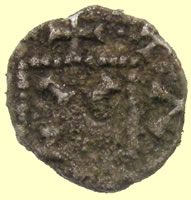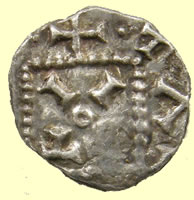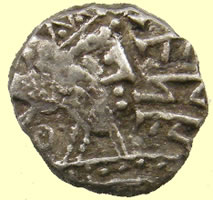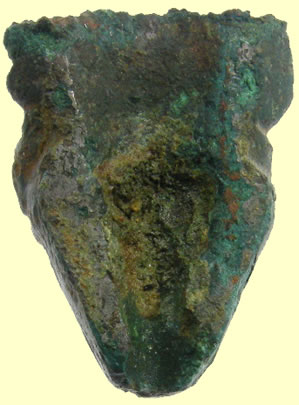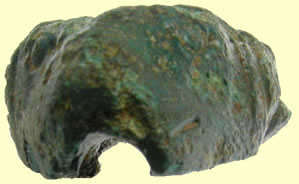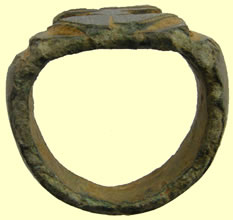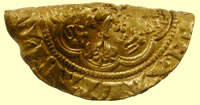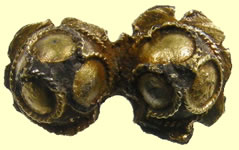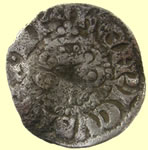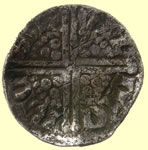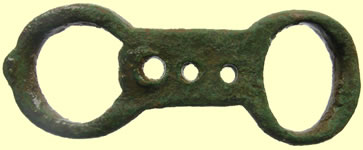

Metal detecting holidays in England with the World's most successful metal detecting club.
Twinned with Midwest Historical Research Society USA
2012 Oct finds page |
Primary Saxon silver sceat 600- 700 AD - 'cooking' it to clean off crust
'Cooked'
Many thanks for this new coin, which is EMC 2012.0210, Series C1. Good luck with the cooking. Best wishes, Martin
|
|||
Exciting find. I was 'cooking' this sceat found last week and thought this silver is too pure for a sceat and then noticed the edge. It is a contemporary forgery with 2 thin sheets of silver over a base inner. First one we have ever found,
I have sent new pictures and an edge shot to Dr Martin at the Fitzwilliam museum for his view
|
|||
  |
|||
| 1894 Victoria milled gold half sovereign | |||
  |
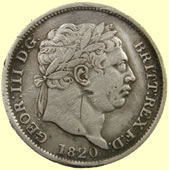 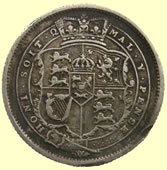 |
||
1204/5 John hammered silver short cross penny - Class 5c Obv HENRICVS REX Rev - *** ON LVNDEI - London mint |
1820 George III milled silver shilling | ||
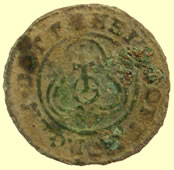 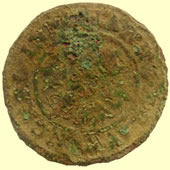 |
  |
||
1586 Hans Krauwincel II Rose orb Jetton HANNS KRAVWINCKEL IN NVRENB |
1215 Henry III hammered silver halfpenny Moneyer Ricard of London mint |
||
 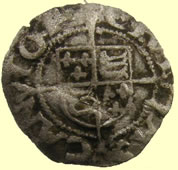 |
 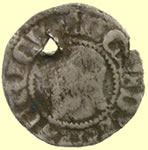 |
||
| 1544-7 Henry VIII hammered silver half groat - Third coinage | It is a sterling (3 penning) of Naestved Mint under Eric of Pommerania ca. 1403-1412/1413. Obv legend- (star)ERICVS:REX:d:S:R. Rev legend- (star)MONETA NESTWED. Obverse features a crown, reverse features a cross. Note- The witten/hvid of 4 penning has a flower versus a star. Your coin reference is Galster #4." and another... "The king's title, REX D S N, alleges that Eric was the king of Denmark, Sweden, and Norway (the three countries were united at that time). But that wasn't entirely true. Margaret I, who adopted him as her son, ruled those three countries from 1376 until her death in 1412. Eric was crowned king in 1397, but mainly to get around the problem that Denmark did not allow female sovereigns. (Margaret had had acted as "regent" prior to that time.) But despite his title, she actually ran things right up to her death in 1412. Just an oddity of history." |
||
 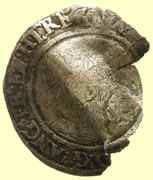 |
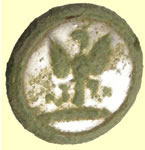 |
 |
|
| 1569 Elizabeth 1st hammered silver sixpence | 19thC livery button | 19thC livery button | |
 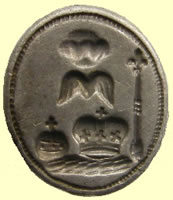 |
|||
| Stunning ecclesiastical 17thC silver seal matrix - reported as treasure to museum | |||
  |
|||
| 10-40 AD Cunobelin Celtic silver unit - 'cooking to remove crust | |||
 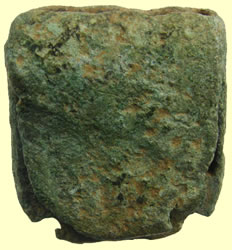 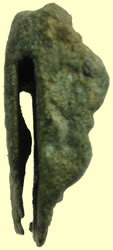 |
|||
| Large Roman bronze hanger - suspension holes below | |||
  |
|||
| Roman bronze item - ornate buckle ? | |||
|
|||
| Roman animal headed bucket mount | |||
  |
|||
| 1901 Victoria milled gold half sovereign | |||
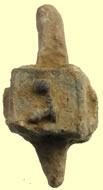  |
 |
 |
|
| dreidel (Yiddish: דרײדל dreydl, Hebrew: סביבון Sevivon) is a four-sided top, played with during the Jewish holiday of Hanukkah. The dreidel is used for a gambling game similar to Teetotum. Each side of the dreidel bears a letter of the Hebrew alphabet: נ (Nun), ג (Gimel), ה (Hei), ש (Shin), which together form the acronym for "נס גדול היה שם" (Nes Gadol Haya Sham – "a great miracle happened there"). These letters also form a mnemonic for the rules of a gambling game played with a dreidel: Nun stands for the Yiddish word nit ("nothing"), Hei stands for halb ("half"), Gimel for gants ("all"), and Shin for shteln ("put"). In the state of Israel, the fourth side of most dreidels is inscribed with the letter פ (Pei), rendering the acronym, נס גדול היה פה, Nes Gadol Haya Po—"A great miracle happened here" referring to the fact that the miracle occurred in the land of Israel | Army button | Military button | |
 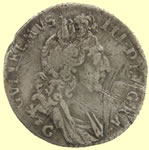 |
 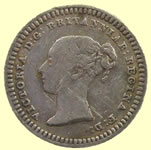 |
||
| 1697 William III milled silver sixpence- Chester mint | 1838 Victoria milled silver three half pence (for Colonial use) | ||
  |
 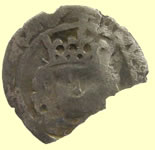 |
||
| 1603-4 James 1st hammered silver half penny | 1422 Henry VI hammered silver penny - York mint - Archiepiscopal issue Quatrefoil with pellet at centre of reverse cross |
||
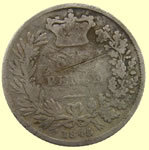 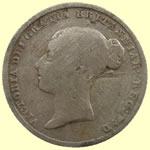 |
  |
||
| 1845 Victoria milled silver six pence | 1906 Edward VII milled silver sixpence | ||
  |
  |
||
| 1500-1700 mount | 1634 Charles 1st hammered copper rose farthing | ||
 |
 |
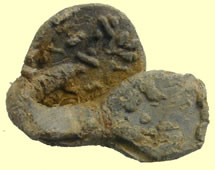  |
|
| 1826 London trade weight | 19thC customs button | Post medieval lead alange cloth seal | |
 |
 |
  |
|
| 17thC button | 1500-1650 buckle | 1215 Henry III hammered silver half penny Rev ** ON CAN - Canterbury mint |
|
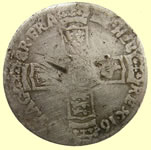 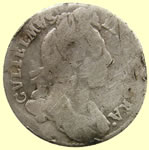 |
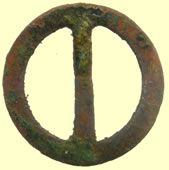 |
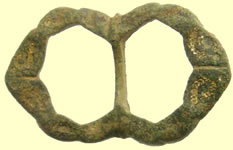 |
|
| 1696 William III milled silver sixpence | Post medieval annular buckle | 1500-1650 buckle | |
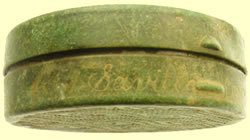 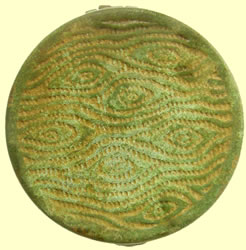  |
|||
| Neat turn of the century pill box - Savilla London | |||
  |
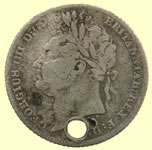 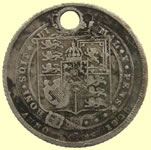 |
||
1215 Henry III hammered silver half penny Rev ** ON LVND - London mint |
1820 George IV milled silver sixpence | ||
 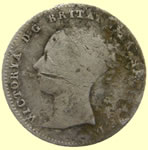 |
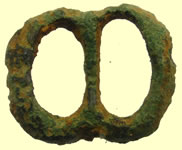 |
 |
|
| 1856 Victoria milled silver three pence | 1500-1650 buckle | 18thC clog fastner | |
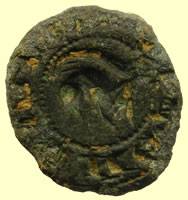 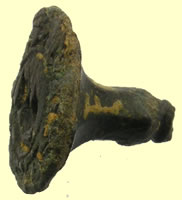 |
|||
| circa 13thC seal matrix | |||
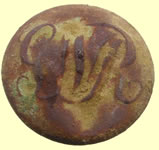 |
 |
 |
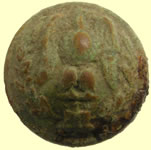 |
| Great western railways button | 1869 Royal Commissariat Staff button | RN Capt / Commander - 1843 RN Lietenant - 1843 RN Master - 1843 RN Surgeon - 1843 RN Purser - 1843 RN Midshipman - 1843 | 1839-1849 The Essex Regiment Back Mark - J Samuel London W1 |
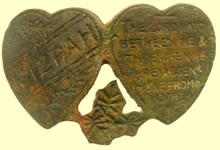 |
  |
||
| Mizpah locket brooch | 1247 Henry III hammered silver voided half penny | ||
 |
 |
  |
|
| 1830's Guild hall London trade weight | 1972 West Ham speedway badge | 2ndC enamelled fibular brooch | |
 |
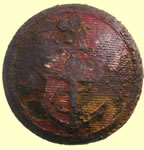 |
  |
|
| 19thC hunting button | UNITED KINGDOM MN - G & J Burns Ltd. In use 1842 | Great condition 1719 George 1st dump issue half penny | |
|
|||
| 1st to 3rd C Roman key ring | |||
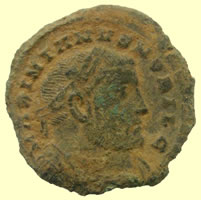 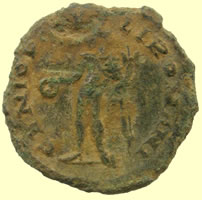 |
|||
3rdC Roman bronze coin sent for ID This is a relatively early follis. As you probably know, the social and economic chaos of the 3rd century was finally brought under control by Diocletian and the tetrarchic system of 2 Augusti and 2 Caesars. This monetary reform created a large (quite nearly the size and weight of a 2nd century sestertius) silvered billon piece the exact name of which we don't know, but is generally called a "Follis". Of course, the stability of neither the political nor the economic reform lasted all that long. When the 2nd Tetrarchy inevitably broke up, it brought about the decades of strife, first with Maxentius and then the Licinii, that Constantine I endured, finally becoming the unchallenged sole ruler of the empire in 324. The most common of the many reverses the follis had over the years while it was declining in size (and buying power, as well, presumably) from the large, silvered "Æ 1" to its final issues c. 320, by which time it had shrunk to approximately the size and weight of a New Penny, was GENIO POPVLI ROMANI - or the Genius of the Roman People with the personification of Genius standing left, generally holding or pouring a libation from a patera. That's what we have here - the reverse, at any rate, is easily ID'd as a Genio Populi Romani type. The obverse and the question of who's on it gave me a bit more trouble. The seemingly clear letters didn't easily fall into line with any of the names I generally associate with the early, large GPR folles - the members of the 1st tetrarchy and the 8 or 10 successors who variously were part of the 2nd tetrarchy, etc.- at first. Then, when I realized what looks like an "X" at about 11:00 was in fact an "A" with an uncharacteristically widely separated top ("A's" generally didn't meet at the top in this era, but this is really unusually widely spaced) it became more obvious that MAXIMIANVS was the name involved. Then we have the issue of what is following the name - generally, and most usually, it would be P F AVG - but it's obviously not. In fact, the first letter after the final "S" in Maximianus is clearly an "N" - and that's uncharacteristically clear for this piece, so it must be a NOB CAES type ending - the title of a Caesar. Maximian, Diocletian's colleague Augustus in the 1st tetrarchy was never a Caesar, however. So, we must have a coin of the only other person who ever used the name MAXIMIANVS - a Caesar in the 1st, then Augustus in the 2nd tetrarchy, who is more commonly called "Galerius". He was Caesar from 293 to 305 when he was elevated to Augustus on the abdication of Diocletian and his namesake Maximian. Looking more closely at the end of the obverse legend, we see it really can't be NOB CAES, however. It turns out to be an unusual NOBIL C and this plus the fact that there is no exergual mint mark on the reverse, instead of making it impossible to tell the mint, actually clearly tells us which mint produced it - the mint that didn't use an exergual mint mark for a while, but did use the unusual NOBIL C title - London. So this piece is a product of the mint of London, a mint which has not been well represented among the pieces you've sent me for ID's. You have an unusual "homeland" variety of the follis type, "GPR", which is so common across the rest of the Empire with exergual mint marks and/or field marks. The reference is RIC VI London # 33 and it dates to 303-305 AD. Mark |
|||
2ndC Roman bronze coin sent for ID If, as you say, this is "sestertius sized", I'd have to say it evidently would be a sestertius of Claudius I on the basis of the portrait - the long neck is particularly associated with Claudius. I can't really see what the reverse is supposed to be, but there were only a very few types of sestertius struck by Claudius. One is an inscription in 4 lines in an oak wreath, and I think we can rule that out pretty easily. The most common is a Spes type with Spes walking left, holding a flower and hitching the hem of her garment. I rotated your photo of the reverse all different ways and couldn't get it to look anything like Spes, either. The 3rd and last sestertius possibility is a triumphal arch with a large equestrian statue on top. - this is pretty unlikely, too, I'd say. What I do see (or think I see) if you rotate the reverse image about 30º CCW is a figure seated facing left. It turns out there is a Claudius Dupondius with this sort of reverse - the CERES AVGVSTA type - here's an example from my collection: http://www.stoa.org/gallery/album88/mark_claudius_dupondius_1 As you can see, the CERES type has a strong "ground line" - and the only fairly clear feature on your piece is a straight line we can see at the bottom of the photo. So, if your piece is a little smallish for a 1st century sestertius (those tended to be in the vicinity of 20gm) and is a bit more like the module of a later sestertius - it might actually be a dupondius of Claudius. It also might be a Dupondius for Divus Augustus by Caligula - see below. If your piece is over 10gm, I'd say that's the most likely ID I can give it. If your piece is lighter still, well under 10gm, there are a couple of types of Caligula with Vesta seated left on the reverse and left-facing portraits, but Caligula's portrait really doesn't look very much like Claudius at all. So, I'm definitely guessing here, but if your piece is smallish for a sestertius (c 28-30 mm) and "solid" (but not "weighty", c 10-15gm) the Ceres Dupondius of Claudius seems to be our best match here. Just for comparison's sake, here is a Vesta reverse on an As of Caligula: http://www.stoa.org/gallery/album88/mark_caligula_as_1 he other piece with a left-seated reverse figure - a posthumous issue for Augustus by Caligula - is also a Dupondius, so it might be mistaken for a sestertius. The portrait of Augustus doesn't look much like Claudius - but they're all in the same family so there are certain similarities. http://www.stoa.org/gallery/album87/07_Augustus_by_Caligula Since I can't seem to see anything on the reverse of your coin but the bulk & legs of a figure seated to the left, these are pretty much the only reasonable possibilities I can see: 1st - Ceres Dupondius by Claudius, Perhaps you, with the coin in-hand, can make comparisions to these various photos and come to your own conclusion. Mark
|
|||
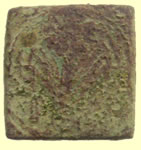 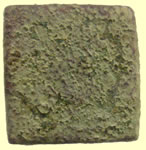 |
 |
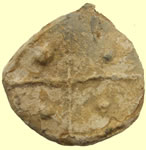 |
|
| 16thC Low counties coin weight - ship with Rose type | 1550-1650 buckle | 15thC lead token - type 2 | |
  |
  |
||
| 2ndC Roman head stud type fibular brooch | 1858 Victoria milled silver 3 pence | ||
 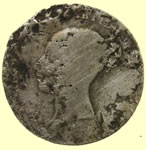 |
 |
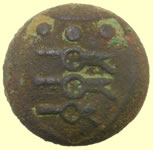 |
|
| 1839 Victoria milled silver 6 pence | 19thC livery button | 18thC Royal artillery button | |
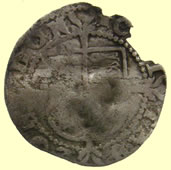 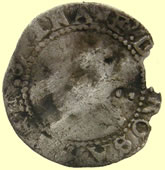 |
 |
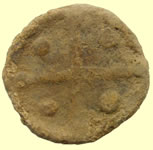 |
|
| 1594-6 Elizabeth 1st hammered silver half groat | Georgian silver thimble | 15thC lead token - type 2 | |
  |
  |
||
| 20thC badge | 1572 Elizabeth 1st hammered silver half groat | ||
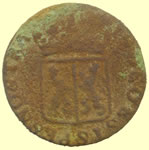  |
  |
||
| 1766 Dutch provinces coin | 1922 George V milled silver sixpence | ||
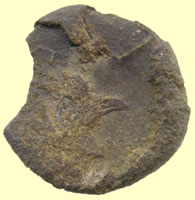 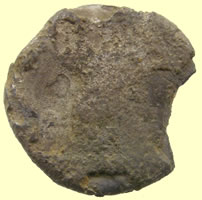 |
|||
| 2ndC crusty Roman silver coin - 'cooking' to remove crust | |||
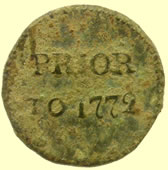 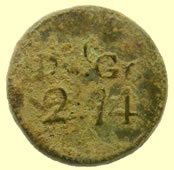 |
 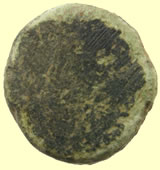 |
||
1772 dated coin weight - these are pennyweights, abbreviated Dwt and grains 2 pennyweight and 18 grains coinweight |
15thC gold noble coin weight Ship with 2 lions type |
||
 |
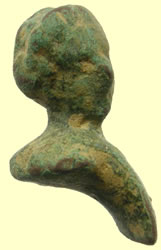 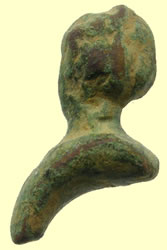 |
||
| 1464 gold Ryal coin weight | Roman bust mount | ||
Victorian window light catcher |
|||
 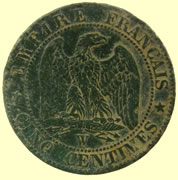 |
  |
||||
| 1855 French Napoleon III copper coin | 1794 Halfpenny of Lancaster (d) OBVERSE: IOHN OF GAUNT DUKE OF LANCASTER. Star under bust. A flaw gives an impression of a nose-ring. REVERSE: Shield with lion. LANCASTER HALFPENNY 1792. EDGE: PAYABLE IN LANCASTER LONDON OR BRISTOL |
||||
  |
|||||
| Very rare find for the Colchester area - 1stC Celtic Bronze unit possible Cunobelin sent to CCI for ID and recording - NY Carter | |||||
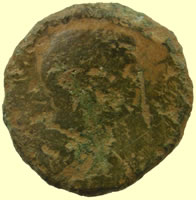 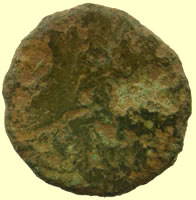 |
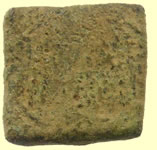 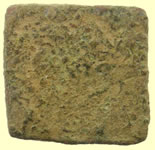 |
||||
| 2ndC Roman bronze coin - sent for ID | 16thC Low counties coin weight | ||||
 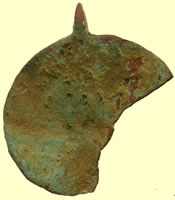 |
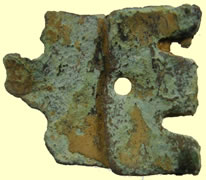  |
||||
| Medieval harnress pendant | Medieval gilded buckle chape | ||||
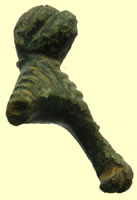  |
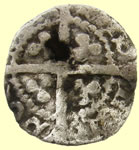 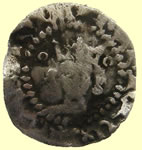 |
||||
| Interesting bronze widget - not sure of use yet | 1413-22 Henry V hammered silver half penny - Type 7 broken annulets by crown Obv + hENRIC x REXxANGL Rev CIVI/TAS/LON/DON - London mint 0.43g, 12.59mm |
||||
 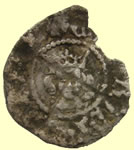 |
  |
||||
1344 Edward III hammered silver half penny - Florin coinage Obv EDWARDVS REX Possible Reading mint 14.04mm |
1344 Edward III hammered silver penny- Florin type Obv EDWAR ANGL DNS HYB Rev CIVI/TAS/LON/DON - London mint |
||||
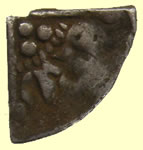  |
  |
||||
1247 Henry III hammered silver voided longcross 1/4 penny Moneyer Stephe |
Medieval long cross hammered silver penny fragment | ||||
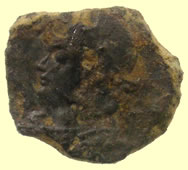  |
 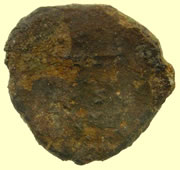 |
||||
Mid 4thC Roman bronze sent for ID For the first one, with the handsome portrait "cameo" and the clearly distinguishable "Campgate" - probably actually a signal tower, but they still call them "campgates" - (you have the image of the reverse upside-down, BTW) - is probably part of the general, system-wide mint emission of PROVIDENTIAE CAESS (for Caesars, "...AVGG" for Augusti) Billon Centenionali (Æ3) campgates of approximately 325 AD. |
Mid 4thC Roman bronze sent for ID The portrait seems to be either some member of the family of Constantine or of the early Valentinian dynasty. The reverse is not immediately recognizeable as any of the more common types of the era with that rectilinear shape and the clear "S" in the middle. The only thing I can think of is the BEATA TRANQVILLITAS series with a globe-topped, stubby memorial altar with a Vota inscription, typically "VOT / IS / XX" for Constantine's 2nd Decennalia - these predate the PROVIDENTIAE campgates by 2 or 3 years. The portraits faced both left and right on these for everyone so we can't make any determination of who, exactly is on the obverse. That's about the best I can do with no legends of any sort visible. Mark |
||||
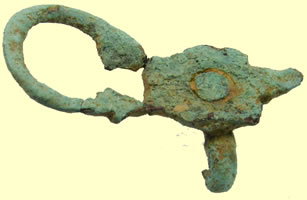 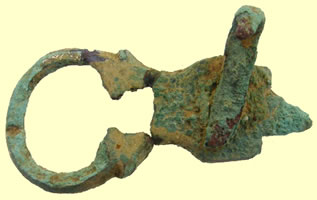 |
|||||
| Unusual medieval gilded buckle with hook arrangement | |||||
 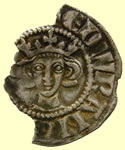 |
 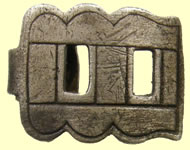 |
||||
1344 Edward III hammered silver penny- Florin type Obv EDWAR ANGL DNS HYB
|
18thc silver clog fastener | ||||
  |
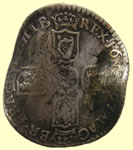 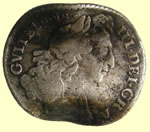 |
||||
1247 Henry III hammered silver voided longcross half penny Oxford mint |
1697 William III milled silver sixpence - love token | ||||
  |
|||||
| Georgian fob seal | |||||
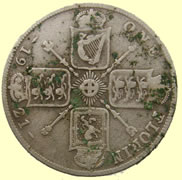  |
 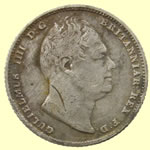 |
||||
| 1921 George V milled silver florin (24 pence) | 1831 William IV milled silver sixpence | ||||
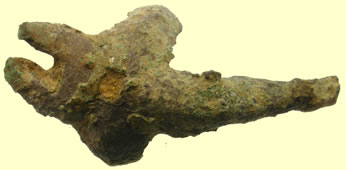 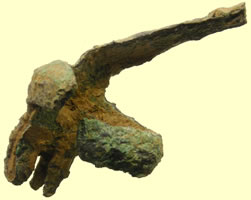 |
|||||
| Medieval harness pendant hanger | |||||
 |
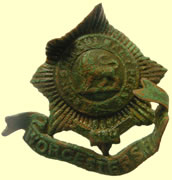 |
||||
| Navy rope badge | Worcestershire Regiment badge | ||||
1362 - 1369 Edward III hammered gold half noble - Treaty Period cross potent- annulet before Edw Obv + EDWARD DEI G REX ANGL 19.16mm, 1.98g |
|||||
 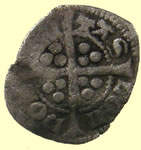 |
  |
||||
1300-1310 Edward 1st hammered silver farthing - oval flan type 28d Obv + EDWARDVS REX A Rev CIVI/TAS/LON/DON - London mint 0.41g,12.12mm |
1594-6 Elizabeth 1st hammered silver half penny - Woolpack mintmark | ||||
 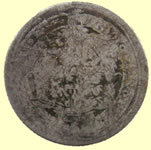 |
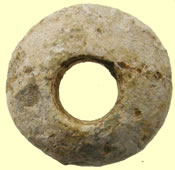 |
 |
|||
| 1817 George III milled silver sixpence | Medieval lead spindle whorl | 1500-1700 mount | |||
  |
|||||
1369 - 1377 Edward III hammered silver penny - cross on breast - Post treaty - satire stops Obv EDWARDVS REX ANGL This coin should be an Edward III Post treaty from York or London mint which has the cross on breast - this coin is a Durham mint - CIVI/TAS/DVN/OLM |
|||||
 |
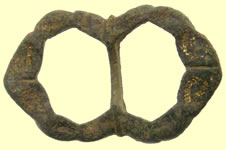 |
 |
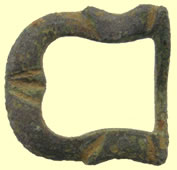 |
||
| Medieval buckle | 1500-1650 buckle | 1500-1700 strap mount | 1500-1650 buckle | ||
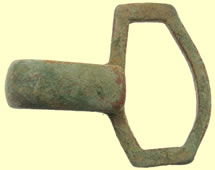 |
 |
 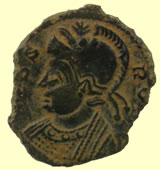 |
|||
| 1500-1700 hooked hanger | 15thC lead token | Mint Roman 4thC Roman coin - sent to Mark for revised ID Shewolf & Twins reverse which is typically found on the VRBS ROMA, City of Rome commemorative, reduced-module folles introduced around 330 AD You're correct in saying that I've probably given you a write-up on Constantine's city commemoratives of c. 330-335. What's special about this one - aside, of course, from the unusually (for Britain) "very kind" diagenesis of the sandy soil - is the very clear PLG exergual mint mark for the mint at Lugdunum (modern Lyon). The coins you tend to find have seldom had such nice, clear mint marks. Aside from that, there's nothing particularly unusual about this piece. There are some scarce pieces in the series on which there are additional marks on the reverse - wreath, branch, leaf, Chi-Rho, etc, but this piece has just the typical 2 stars in the upper field - these symbolize both the twins Romulus & Remus who founded Rome and the now "twin" capital cities of Rome and Constantinople. Mark
|
|||
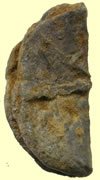  |
 |
 |
|||
| Medieval Boy Bishop lead token | 17thC lead token | 15thC lead token | |||
 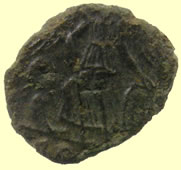 |
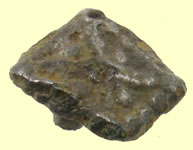 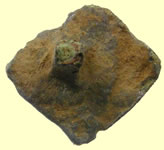 |
||||
| Roman 4thC Roman coin - sent to Mark for ID This one is the other half of the "set" - the last one was an VRBS ROMA city commemorative with the personification of Rome as an armored female figure and the anepigraphic portrayal of the classic wolf and twins scene emblematic of and symbolic for Rome. This one is the CONSTANTINOPOLIS type, with Constantinople portrayed as an armored female figure and the anepigraphic reverse with Victory standing in the prow of a galley sailing to the left, holding a spear and resting on a shield. It would be interesting to be able to see clearly what the exergual mint mark was supposed to be on this piece - whether it was also struck at Lugdunum like the VRBS ROMA piece - but as I look at what remains visible of the tops of letters in this one's mint mark, I suspect that it's more likely to be from the mint at Rome, Arles or Aquilea, but there's too little visible to be certain which it is. Mark
|
Medieval silver mount - reported to museum as treasure | ||||
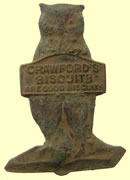 |
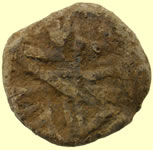 |
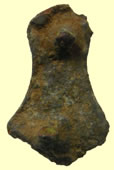  |
|||
| Crawfords biscuits badge | 17thC lead token | 1500-1700 mount | |||
 |
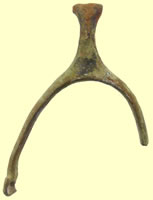 |
 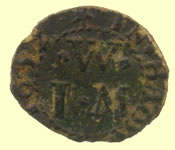 |
|||
| Georgian watch winder | Georgian spur | 1652 John Vandewall of Harwich Essex hammered copper trade farthing | |||
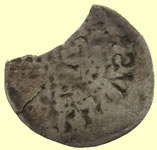 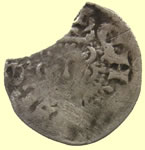 |
  |
||||
| Very wierd 1247 Henry III hammered silver voided long cross penny - weakly off strike on a thick silver planchet | 1344 Edward III hammered silver penny - Cross 3 Obv EDWAR ANGL DNS HYB Rev CIVI/TAS/LON/DON - London mint |
||||
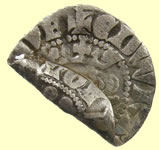 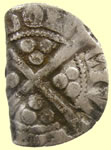 |
 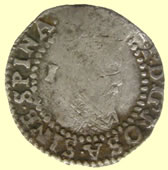 |
||||
1344 Edward III hammered silver penny - Cross 3 Obv EDWR ANGL DNS HYB Rev CIVI/TAS/LON/DON - London mint |
1603 -4 James 1st hammered silver penny | ||||
  |
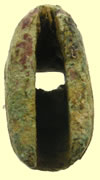 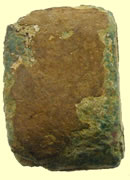 |
||||
| Medieval hammered silver penny fragment - CIVI TAS type | Medieval knife quillion | ||||
 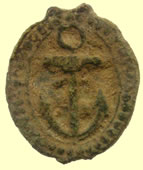 |
  |
||||
| Navy watch winder | 1909 Edward VII milled silver sixpence | ||||
 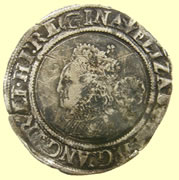 |
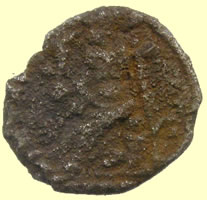 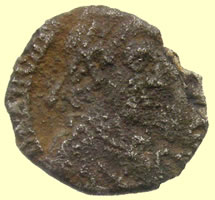 |
||||
| 1561 Elizabeth 1st hammered silver sixpence | 4thC Roman silver coin - 'cooking' to remove crust | ||||
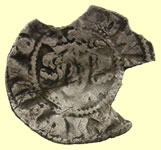  |
 |
||||
1327 Edward III hammered silver penny Obv EDW *** ANGL DNS H** Rev CIVI/TAS/DVR/**E - Durham mint |
18thC Royal navy silver cufflinks | ||||
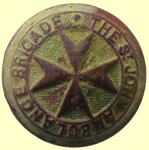 |
|
|
|||
| St Johns Ambulance Brigade button | 18thC monogrammed silver thimble | 16thC gold on silver Tudor mount - reported as treasure to museum | |||
  |
|||||
1856 Australian half sovereign - Sydney Mint - very scare A gold coin (19 mm diameter with milled edge) featuring a head of Queen Victoria facing left with the date 1856 below. The reverse features the word AUSTRALIA below a royal crown within a wreath of laurel and with the words SYDNEY MINT above and HALF SOVEREIGN below. |
|||||
  |
   |
||||
| Medieval decorated buckle | Medieval gilded harness pendant | ||||
 |
 |
 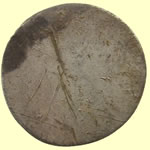 |
|||
| 18thC toy cannon | 16thC button | 1696 William III milled silver sixpence | |||
  |
  |
||||
| 1558-60 Elizabeth 1st hammered silver penny - First issue Lis mintmark | 1180 - 1189 Henry II hammered silver short cross half penny - Class 1 Rev *LDWINE - Moneyer Goldwine |
||||
|
 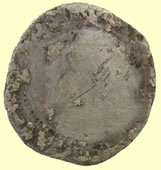 |
||||
1247 Henry III voided long cross hammered silver penny - Class IIa Obv HENRICVS REX Rev RIC/ARD/ONL/INC - Moneyer Ricard of Lincoln mint |
16thC Elizabeth 1st hammerd silver half groat | ||||
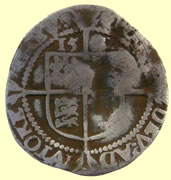  |
 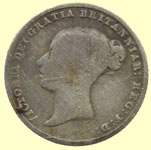 |
||||
| 1584-6 Elizabeth 1st hammered silver sixpence | 1857 Victoria milled silver sixpence | ||||
  |
|
||||
1344 Edward III hammered silver penny - Cross 3 Obv EDWR ANGL DNS HYB Rev CIVI/TAS/LON/DON - London mint |
Medieval harness buckle | ||||
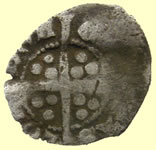  |
  |
||||
1344 Edward III hammered silver farthing - Type 1 Obv EDWARDVS REX A Rev CIVI/TAS/LON/DON - London mint 0.33g, 12mm |
1509 - 47 Henry VII hammered silver groat fragment | ||||
 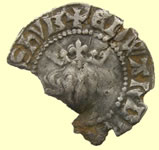 |
 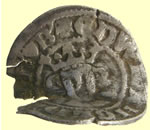 |
||||
1361- 69 Edward III hammered silver penny - Cross 3 - Treaty period Obv EDWARD *** HYB Rev CIVI/TAS/LON/DON - London mint |
1344 Edward III hammered silver penny - Cross 3 Obv EDWR ANGL DNS HYB Rev CIVI/TAS/CAN/TOR - Canterbury mint |
||||
  |
|
||||
| 1500-1700 mount | 17thC knife pommel | ||||
  |
  |
||||
| 17thC lead token | Georgian seal matrix | ||||
  |
  |
||||
| Medieval hammered silver long corss penny | 1603 James 1st hammered silver penny | ||||
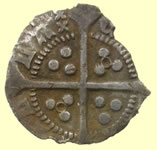 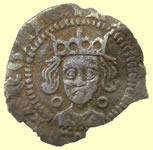 |
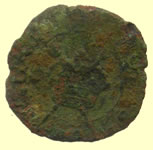  |
||||
1422-1461 Henry VI hammered silver penny - annulet issue Obv HENRICVS REX ANGLIE Rev VIL/LA/ CAL/ISIE Calais mint |
1634 Charles 1st hammered copper rose farthing | ||||
  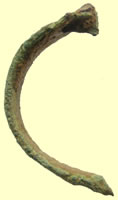 |
|||||
| 1st C Colchester type Roman fibular brooch | |||||
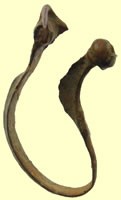   |
|
||||
| 1st C Aucissa type Roman fibular brooch | Complete post medieval lead alnage cloth seal | ||||
 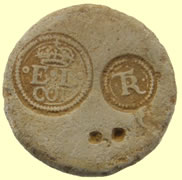 |
 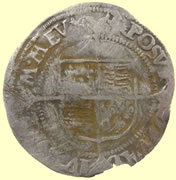 |
||||
| 16thC lead trade weight | 1584-6 Elizabeth 1st hammered silver sixpence | ||||
 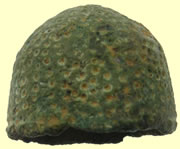 |
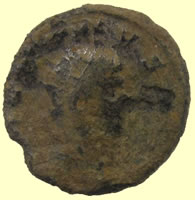 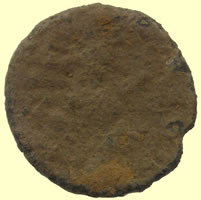 |
||||
| Medieval bronze beehive thimble | 2ndC Roman silver coin - cooking to remove crust The first piece is an antoninianus of Gallienus - 253-268 - from the later part of his reign. It was during his reign that Roman "silver" coins finally became so debased that they could no longer masquerade as silver without an exterior wash or plating of silver. Obviously I can't tell you what the reverse type is. Gallienus was probably the most prolific coiner of different reverse types in the Empire - there are over 1000 types listed for him in RSC, for example. |
||||
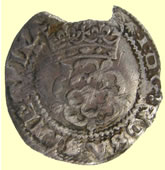  |
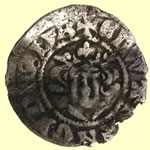  |
||||
| 1603 James 1st hammered silver half groat | 1344 Edward III hammered silver penny - Cross 3 Obv EDWAR ANGL DNS HYB Rev CIVI/TAS/LON/DON - London mint |
||||
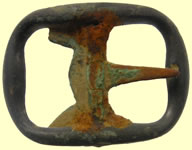 |
  |
||||
| 1550-1700 buckle | First 1500- 1700 enamelled and decorated mount of this type I have seen | ||||
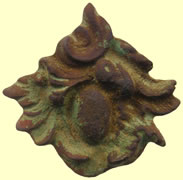  |
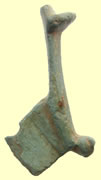 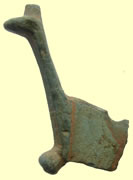 |
||||
| Georgian mount | 2ndC Roman fibular brooch - type not Id'd | ||||
 |
 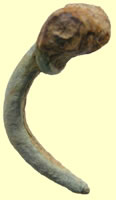 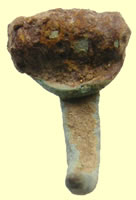 |
||||
| 2nd C - 1st C La Tene type Roman fibular brooch | 1st C Dolpin type Roman fibular brooch | ||||
Great condition large Roman copper - sent to Mark Lehman for ID 9.15g, 26.69mm Due to the corroded state and the identification problems it causes, I'll need to take some time to figure out who's on the obverse and reverse, but this is a Roman Provincial issue from Markianopolis in Thrace / Moesia Inferior. Inscribed in Greek, I believe this is a very unusual piece to find in Britain. Although the mint cities in this part of Thrace / Moesia were extremely prolific in the 3rd century, this piece from the hinterlands northwest of the Black Sea is thousands of miles from home. I haven't figured out who's on the reverse, either - and that may be the reason. If it's a deity or personification of special importance to someone - for example, Asclepios to someone with health issues - (although this definitely isn't Asklepios) might be a reason for someone to have carried this piece 2 or 3 thousand miles from one end of the Empire to the other. I doubt it was considered "legal tender" in Britain at the time - these were local issues denominated for local trade in Moesia. I'll get back to you when/if I can figure out who the emperor & reverse characters are. Giving the obverse a 2nd look, I believe this is Elagabalus. If I can figure out enough of the legend to be certain, I'll let you know. Mark On closer inspection, I am pretty well convinced that this is Severus Alexander (the last member of the Severan Dynasty) 222-235 AD. As I said, it's from Markianopolis in Moesia Inferior (approximately Bulgaria/Romania today) one of the most prolific local "Provincial" mints in the Roman East. It produced a local currency denominated in "Assaria" - this piece is a "Pentassarion", or 5 Assaria. The legends are all in Greek - I believe I already mentioned this. The Provincial mints struck in the local language and by the 3rd century the vast majority of the citizens of the Roman Empire spoke Greek exclusively.
The legend on the reverse names 1st the magistrate, then gives the "ethnic" - the name of the issuing locale:
|
|||||
 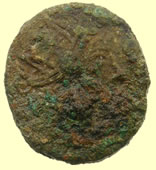 |
  |
||||
4thC Roman radiate sent for ID The one you have labelled "Radiate" is a 3rd century contemporary copy of the sort some call a "barbarous radiate" - I'm not going to go into the reasons I don't like that term again here, you can check my earlier comments on the subject. I can't tell who this is supposed to be nor what the reverse type might have been, but Tetricus' more common antoniniani are the most commonly copied subjects of pieces of this class - these date to the end of the so-called Gallic Empire when it was faltering - ie: 265-270 AD. |
4thC Roman washed silver coin - sent for ID the 2nd piece is too crusty for me to get much out of it, although the obverse legend retains a couple of legible letters, I haven't been able to quite place them into an Imperial title for anyone in particular, yet. I'll get back to you on this. Given a 2nd look, I believe this might be Postumus - or a contemporary copy of one of his types - the founder of the so-called Gallic Empire. |
||||
More Oct finds on a new page |
|||||


